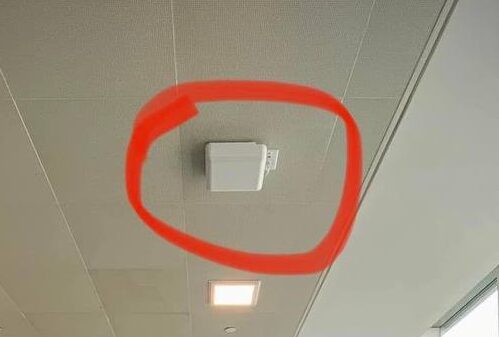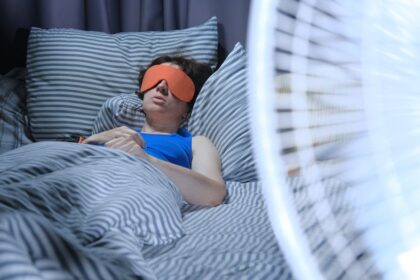In our local airports, schools, and even hospitals, an inconspicuous danger now lurks overhead. Mounted discreetly on ceilings, these seemingly innocent “white boxes” have become an integral part of our modern infrastructure.
However, what remains hidden from our immediate perception is the invisible sea of radiation they emit, penetrating the very spaces we inhabit. As we uncover the potential health implications and explore ways to minimize exposure, it becomes evident that awareness is the first crucial step toward mitigating their effects.
Outdated Regulations and Unseen Dangers
As we become increasingly dependent on technology, the landscapes of our daily lives are continually reshaped by its advancements. Airports, schools, hospitals, and other public spaces have embraced the convenience of wireless connectivity, enhancing our experiences and streamlining our interactions.
However, the story that unfolds above our heads is far from benign. The Federal Communications Commission (FCC), the governing body responsible for setting wireless radiation exposure limits in the United States, last updated these limits in 1996 – a staggering 27 years ago.
In the realm of technology, where progress leaps forward with each passing year, this time gap is monumental. The exposure limits established over a quarter-century ago were based on a technological landscape vastly different from what we experience today.
It’s crucial to comprehend that the current FCC exposure limits have not evolved to reflect the transformed technological and societal dynamics. Even more concerning is the fact that these limits fail to consider the comprehensive body of scientific research that demonstrates the potential biological effects associated with chronic exposure to wireless radiation.
This oversight is significant, as studies have unveiled connections between prolonged wireless radiation exposure and various health concerns, ranging from disrupted sleep patterns and increased stress levels to more serious long-term implications.
It’s no longer sufficient to rely on the assurances of telecom providers that their wireless products adhere to FCC radiation limits and are therefore “safe.” The reality is that these limits are out of sync with the current scientific understanding of the risks posed by wireless radiation.
To trust solely in these outdated benchmarks is to disregard the wealth of information that has emerged since their establishment.
Peer-Reviewed Scientific Research on Wireless Radiation Health Effects
In a world increasingly interconnected by wireless technology, it’s essential to consider the invisible but potentially profound impact of radiofrequency radiation emitted by cell phones and wireless devices. The scientific community has conducted an extensive array of peer-reviewed studies to explore the potential health effects of this radiation – a complex and pressing matter that demands our attention.
Cell Phones and Wireless Radiation: The Biological Toll
Scientific investigation into the effects of wireless radiation has revealed a disconcerting range of adverse health impacts. These effects span from disruptions in reproductive functions to the damaging alteration of DNA strands, the generation of harmful reactive oxygen species, compromised immune system responses, stress protein synthesis within the brain, impaired brain development, and disturbances in critical functions such as sleep and memory. The link between wireless radiation and an increased risk of brain tumors also raises significant concerns.
Quoting the European Commission, “Waiting for high levels of scientific and clinical proof before taking action to prevent well-known risks can lead to very high health and economic costs.” The gravity of this statement becomes clear when considering the tragic history of substances like asbestos, leaded petrol, and tobacco. As we navigate the realm of wireless technology, it’s crucial to heed these lessons and prioritize precaution.
The Disconnect Between Research & Regulation
A central paradox emerges as the research unfolds: the harmful effects of wireless radiation consistently manifest at exposure levels far below the current international standards, which were established over two decades ago. Adding to this complexity, these exposure levels often originate from government-approved devices legally accessible to the general public.
This stark disconnect between scientific findings and regulatory standards is a glaring testament to the urgency of updating these standards to align with the latest research.
The World Health Organization’s classification of wireless radiation as a Class 2B Possible Human Carcinogen in 2011 underscores the gravity of the issue. Since this classification, the body of evidence linking wireless radiation to cancer and other health risks has only grown stronger and more compelling.
The Research On Wireless Radiation
The diverse range of health implications associated with wireless radiation is a testament to its far-reaching effects. A notable example is the increased risk of brain cancer among heavy cell phone users, a risk acknowledged by the World Health Organization’s International Agency for Research on Cancer. Dr. Hardell’s research further highlights an alarming eight-fold increase in brain cancer risk for those who began using cell or cordless phones during their teenage years.
Children, too, are not immune, as studies suggest a rise in brain cancer risk associated with prolonged cell phone use.
The study by Lerchl et al. (2015), replicating the tumor-promoting effects of wireless radiation at levels below exposure limits, underscores the urgency of updated regulatory frameworks. Similarly, the correlation between low-intensity radiofrequency radiation and oxidative stress cannot be ignored, given its potential to induce DNA damage and a cascade of health consequences.
Awareness and Action
The collective weight of scientific evidence places an ethical imperative upon society to reconsider our relationship with wireless technology. The unquestioned acceptance of its safety no longer aligns with the breadth of research findings.
Acknowledging this reality, demanding updated regulatory standards, and prioritizing the well-being of current and future generations is a step toward preserving our health in the face of unprecedented technological advancements.
As we navigate this intricate web of research, it’s clear that wireless radiation’s impact stretches beyond individual health concerns. The very fabric of our interconnected society is woven with wireless technology, making it all the more critical to ensure that its foundations are built on robust scientific understanding.
The following sections delve into specific research findings, presenting an unignorable case for reevaluating our approach to wireless technology and its regulation.
Reduce Your Exposure To Wireless Radiation
Reducing your exposure to wireless radiation involves a combination of conscious choices, practical adjustments, and informed decision-making. While complete avoidance may not be feasible in today’s interconnected world, these steps can significantly mitigate your exposure:
- Distance is Key: The intensity of wireless radiation decreases with distance from the source. Whenever possible, maintain a safe distance from wireless devices, such as cell phones, routers, and laptops.
- Turn off Wireless Devices: Turn off Wi-Fi, Bluetooth, and cellular data when not in use. This not only reduces exposure but also conserves battery life.
- Use Airplane Mode: When you don’t need to make calls or access the internet, switch your device to airplane mode. This limits its wireless emissions.
- Wired Connections: Opt for wired connections whenever possible. Use Ethernet cables for internet connections, and connect wired headphones instead of using Bluetooth.
- Hardwired Devices: Replace wireless devices with wired alternatives. For example, use a corded landline phone instead of a cordless one, and connect your computer directly to the router with an Ethernet cable.
- Use Speakerphone or Headphones: When making calls, use the speakerphone function or wired headphones to keep your device away from your head.
- Text Instead of Calling: Send text messages instead of making calls whenever appropriate. This reduces the proximity of the device to your body.
- Limit Screen Time: Reducing overall screen time on wireless devices not only lowers exposure but also promotes better sleep and well-being.
- Use Shields: Consider using shielding products, such as cases, covers, and shields for devices, to reduce direct radiation exposure.
- Disable Auto-Connect: Disable auto-connect to public Wi-Fi networks to prevent your device from constantly searching for and connecting to available networks.
- Use Wired Baby Monitors: If you use baby monitors, opt for wired versions to avoid exposing infants to unnecessary wireless radiation.
- Choose Low-Radiation Devices: Research and select devices with lower Specific Absorption Rate (SAR) values, indicating lower radiation emission levels.
- Sleep Away from Devices: Keep your bedroom a technology-free zone, or at least keep devices away from your sleeping area to minimize nighttime exposure.
- Limit Wireless Toys: Be mindful of wireless toys, gadgets, and wearable devices that emit radiation. Opt for non-wireless alternatives.
- Disable Background Apps: Disable apps that require constant internet access or location services when not needed.
- Educate Yourself: Stay informed about the potential sources of wireless radiation and make conscious choices based on your understanding.
- Create Tech-Free Zones: Designate certain areas of your home as tech-free zones, such as the dining table or the bedroom.
- Use Wired Accessories: Utilize wired accessories, such as keyboards and mice, instead of wireless ones that emit radiation.
- Go Offline: Engage in offline activities like reading physical books, going for walks, and spending time in nature to reduce device usage.
- Promote Safe Usage: Educate your family and friends about the importance of reducing wireless radiation exposure and encourage them to adopt similar practices.
Remember that minimizing exposure to wireless radiation contributes to your overall health and well-being. While it may not be possible to eliminate all sources of exposure, adopting these practices can significantly reduce the potential risks associated with prolonged and excessive exposure.
I Take Radiate 21 when I travel… It Contains Powerful Antioxidants Work To Safeguard Your Body Against The Oxidative & Free Radical Damage Caused By EMF Radiation
Click Here To Learn More About Radiate 21
Embracing Change: Paving the Way for Safer Environments
As we navigate the intricate terrain of wireless technology and its associated risks, it becomes evident that informed decisions are the cornerstone of safeguarding our well-being. The unassuming “white boxes” that silently populate our public spaces serve as a poignant reminder of the unseen forces that permeate our lives. However, the tides are turning as awareness deepens and a collective voice rises.

The growing understanding of the potential hazards linked to wireless radiation has prompted many hospitals and schools to take a proactive stance. Across the globe, petitions have circulated, calling for the removal and ban of these powerful radiation-emitting antennas. The vision is clear – a transition toward hard-wired Ethernet connections that offer the dual benefit of reduced radiation exposure and enhanced security.

The movement to replace wireless technology with wired alternatives signifies more than a mere change in infrastructure. It reflects a broader shift toward prioritizing human health and resilience in the face of technological advancements. Hospitals, places of healing, are striving to ensure that patients are not inadvertently exposed to potential harm while seeking treatment. Schools, centers of learning, are fostering environments that embrace connectivity without compromising the delicate balance of young minds and bodies.
In these crucial spaces, the conversation is evolving from one solely centered around connectivity to one that intricately weaves health considerations into the fabric of decision-making. The advocacy for hard-wired connections demonstrates a commitment to aligning policies and practices with the latest scientific insights. It symbolizes a commitment to ensuring that our present and future generations thrive in environments where learning and healing flourish unhindered by the invisible dangers of wireless radiation.
As society moves forward, it is our collective responsibility to continue championing the cause of safer spaces. By raising our voices, disseminating knowledge, and advocating for change, we contribute to a paradigm where technology and well-being harmoniously coexist. The white boxes that have quietly adorned our ceilings serve as a reminder of the journey ahead – one of resilience, informed choices, and a commitment to fostering environments that prioritize human health above all else.






